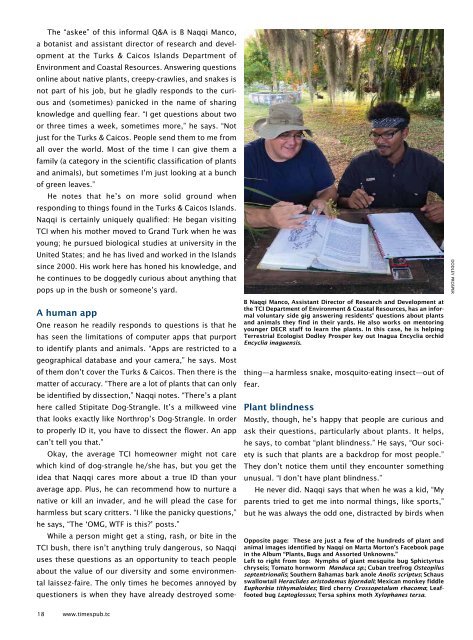Times of the Islands Fall 2022
Presents the "soul of the Turks & Caicos Islands" with in-depth features about local people, culture, history, environment, real estate, businesses, resorts, restaurants and activities.
Presents the "soul of the Turks & Caicos Islands" with in-depth features about local people, culture, history, environment, real estate, businesses, resorts, restaurants and activities.
You also want an ePaper? Increase the reach of your titles
YUMPU automatically turns print PDFs into web optimized ePapers that Google loves.
B Naqqi Manco, Assistant Director <strong>of</strong> Research and Development at<br />
<strong>the</strong> TCI Department <strong>of</strong> Environment & Coastal Resources, has an informal<br />
voluntary side gig answering residents’ questions about plants<br />
and animals <strong>the</strong>y find in <strong>the</strong>ir yards. He also works on mentoring<br />
younger DECR staff to learn <strong>the</strong> plants. In this case, he is helping<br />
Terrestrial Ecologist Dodley Prosper key out Inagua Encyclia orchid<br />
Encyclia inaguensis.<br />
The “askee” <strong>of</strong> this informal Q&A is B Naqqi Manco,<br />
a botanist and assistant director <strong>of</strong> research and development<br />
at <strong>the</strong> Turks & Caicos <strong>Islands</strong> Department <strong>of</strong><br />
Environment and Coastal Resources. Answering questions<br />
online about native plants, creepy-crawlies, and snakes is<br />
not part <strong>of</strong> his job, but he gladly responds to <strong>the</strong> curious<br />
and (sometimes) panicked in <strong>the</strong> name <strong>of</strong> sharing<br />
knowledge and quelling fear. “I get questions about two<br />
or three times a week, sometimes more,” he says. “Not<br />
just for <strong>the</strong> Turks & Caicos. People send <strong>the</strong>m to me from<br />
all over <strong>the</strong> world. Most <strong>of</strong> <strong>the</strong> time I can give <strong>the</strong>m a<br />
family (a category in <strong>the</strong> scientific classification <strong>of</strong> plants<br />
and animals), but sometimes I’m just looking at a bunch<br />
<strong>of</strong> green leaves.”<br />
He notes that he’s on more solid ground when<br />
responding to things found in <strong>the</strong> Turks & Caicos <strong>Islands</strong>.<br />
Naqqi is certainly uniquely qualified: He began visiting<br />
TCI when his mo<strong>the</strong>r moved to Grand Turk when he was<br />
young; he pursued biological studies at university in <strong>the</strong><br />
United States; and he has lived and worked in <strong>the</strong> <strong>Islands</strong><br />
since 2000. His work here has honed his knowledge, and<br />
he continues to be doggedly curious about anything that<br />
pops up in <strong>the</strong> bush or someone’s yard.<br />
A human app<br />
One reason he readily responds to questions is that he<br />
has seen <strong>the</strong> limitations <strong>of</strong> computer apps that purport<br />
to identify plants and animals. “Apps are restricted to a<br />
geographical database and your camera,” he says. Most<br />
<strong>of</strong> <strong>the</strong>m don’t cover <strong>the</strong> Turks & Caicos. Then <strong>the</strong>re is <strong>the</strong><br />
matter <strong>of</strong> accuracy. “There are a lot <strong>of</strong> plants that can only<br />
be identified by dissection,” Naqqi notes. “There’s a plant<br />
here called Stipitate Dog-Strangle. It’s a milkweed vine<br />
that looks exactly like Northrop’s Dog-Strangle. In order<br />
to properly ID it, you have to dissect <strong>the</strong> flower. An app<br />
can’t tell you that.”<br />
Okay, <strong>the</strong> average TCI homeowner might not care<br />
which kind <strong>of</strong> dog-strangle he/she has, but you get <strong>the</strong><br />
idea that Naqqi cares more about a true ID than your<br />
average app. Plus, he can recommend how to nurture a<br />
native or kill an invader, and he will plead <strong>the</strong> case for<br />
harmless but scary critters. “I like <strong>the</strong> panicky questions,”<br />
he says, “The ‘OMG, WTF is this?’ posts.”<br />
While a person might get a sting, rash, or bite in <strong>the</strong><br />
TCI bush, <strong>the</strong>re isn’t anything truly dangerous, so Naqqi<br />
uses <strong>the</strong>se questions as an opportunity to teach people<br />
about <strong>the</strong> value <strong>of</strong> our diversity and some environmental<br />
laissez-faire. The only times he becomes annoyed by<br />
questioners is when <strong>the</strong>y have already destroyed something—a<br />
harmless snake, mosquito-eating insect—out <strong>of</strong><br />
fear.<br />
Plant blindness<br />
Mostly, though, he’s happy that people are curious and<br />
ask <strong>the</strong>ir questions, particularly about plants. It helps,<br />
he says, to combat “plant blindness.” He says, “Our society<br />
is such that plants are a backdrop for most people.”<br />
They don’t notice <strong>the</strong>m until <strong>the</strong>y encounter something<br />
unusual. “I don’t have plant blindness.”<br />
He never did. Naqqi says that when he was a kid, “My<br />
parents tried to get me into normal things, like sports,”<br />
but he was always <strong>the</strong> odd one, distracted by birds when<br />
Opposite page: These are just a few <strong>of</strong> <strong>the</strong> hundreds <strong>of</strong> plant and<br />
animal images identified by Naqqi on Marta Morton’s Facebook page<br />
in <strong>the</strong> Album “Plants, Bugs and Assorted Unknowns.”<br />
Left to right from top: Nymphs <strong>of</strong> giant mesquite bug Sphictyrtus<br />
chryseis; Tomato hornworm Manduca sp.; Cuban treefrog Osteopilus<br />
septentrionalis; Sou<strong>the</strong>rn Bahamas bark anole Anolis scriptus; Schaus<br />
swallowtail Heraclides aristodemus bjorndali; Mexican monkey fiddle<br />
Euphorbia tithymaloides; Bird cherry Crossopetalum rhacoma; Leaffooted<br />
bug Leptoglossus; Tersa sphinx moth Xylophanes tersa.<br />
DODLEY PROSPER<br />
18 www.timespub.tc
















